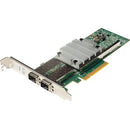Description
Veritas QLE8442 10Gigabit Ethernet Card
The Veritas QLE8442 10Gigabit Ethernet Card is engineered for modern data centers, high-performance servers, and demanding virtualization environments. Built on PCI Express 3.0 x8, this dual-port NIC delivers scalable, high-throughput networking with low latency, making it an ideal upgrade for storage networks, hyper-converged infrastructure, and clustered applications. With two 10GBASE-X optical fiber ports, it provides flexible, future-proof connectivity that supports rapid data movement, seamless virtualization, and reliable, consistent performance under heavy workloads. Whether you’re accelerating IT services, optimizing data center efficiency, or expanding bandwidth without adding complexity, the QLE8442 is designed to help you maximize throughput, reduce bottlenecks, and simplify network architecture.
- High-throughput dual 10G Ethernet ports: The Veritas QLE8442 features two 10GBASE-X optical fiber interfaces, delivering up to 20 Gbps of aggregate bandwidth in full duplex. This enables fast backups, rapid data replication, and smooth virtualization for multi-tenant environments, while keeping latency low and predictability high for critical workloads.
- PCIe 3.0 x8 architecture for efficient server I/O: Designed to slide into a PCIe 3.0 x8 slot, the QLE8442 offers robust I/O performance with ample headroom for burst traffic, ensuring your CPUs and storage subsystems aren’t starved by network operations. The card is optimized to minimize PCIe congestion in busy servers, helping to maintain consistent application performance.
- Flexible optical connectivity with optical fiber SFP+ ports: Equipped with two SFP+ ports for 10GBASE-X, the card supports a wide range of fiber transceivers and fiber optic configurations. This flexibility is ideal for data centers employing fiber-channel-style storage networks, replication, or remote site connectivity, while enabling precise distance and interference control.
- Reliable performance for virtualized and storage-intensive workloads: The QLE8442 is crafted to handle virtualization, clustering, and storage-centric tasks with ease. Expect stable throughput under concurrent virtual machines, rapid virtual desktop deployments, and efficient large-file transfers, all while maintaining predictable latency critical to real-time applications.
- OS compatibility and easy integration into existing environments: This plug-in NIC is compatible with a wide range of server operating systems and leverages standard NIC drivers provided by major OS vendors. Its straightforward install and broad support simplify integration into existing rack, blade, or tower servers without requiring extensive reconfiguration or specialized firmware updates.
Technical Details of Veritas QLE8442 10Gigabit Ethernet Card
- Interface: PCI Express 3.0 x8, compatible with x8 and higher PCIe slots for optimal bandwidth and compatibility in modern servers.
- Ports: 2 x 10GBASE-X SFP+ optical fiber ports for flexible fiber connectivity and long-reach networking.
- Throughput: Up to 20 Gbps aggregate bandwidth in full duplex across both ports (approximate; real-world performance varies with transceivers, fiber, and system load).
- Form factor: PCIe plug-in card designed for standard server chassis with adequate clearance and ventilation; suitable for data center racks and enterprise servers.
- Compatibility: Supports common server operating systems with standard NIC drivers; proven interoperability with a broad ecosystem of transceivers and fiber configurations.
how to install Veritas QLE8442 10Gigabit Ethernet Card
- Prepare your system: Power down the server, unplug the power cord, and discharge any static buildup. Open the chassis and identify a free PCIe slot that is x8 or larger and has adequate clearance for the card’s height and connectors.
- Insert the card: Insert the Veritas QLE8442 into the PCIe slot until it seats firmly. Ensure the retention bracket aligns with the chassis and secure the card with the screw for mechanical stability.
- Install fiber transceivers and cables: Insert compatible SFP+ fiber transceivers into the two optical ports. Connect fiber optic cable runs to the transceivers, ensuring proper polarity and distance per your network design.
- Power up and install drivers: Reassemble the chassis, reconnect power, and boot the server. Install the appropriate drivers and management utilities from the vendor or OS distribution, then reboot if prompted.
- Configure network interfaces: In your operating system, identify the two new NIC interfaces, assign IP addresses, VLANs, or bonding configurations as needed, and test connectivity with ping, throughput tests, and traffic generators to validate correct operation.
Frequently asked questions
Q: What kind of performance can I expect from the Veritas QLE8442?
A: The card provides dual 10GBASE-X ports, offering up to 20 Gbps total aggregate bandwidth in full duplex. Real-world throughput depends on transceivers, fiber type, switch/router support, and system workload, but the QLE8442 is designed to deliver predictable, low-latency performance for virtualization, storage replication, and high-bandwidth workloads.
Q: Which operating systems are supported?
A: The QLE8442 is designed to work with major server operating systems and relies on standard NIC drivers provided by OS vendors. It is suitable for Linux distributions, Windows Server editions, and other enterprise-class environments, with drivers and management utilities typically available from Veritas or the hardware vendor’s repository.
Q: Do I need a specific fiber transceiver to use the ports?
A: Yes. Each 10GBASE-X SFP+ port requires a compatible SFP+ transceiver suitable for your fiber type (single-mode or multimode) and distance. Choose transceivers that match your network design and verify compatibility with the card model and your switches.
Q: Is this card suitable for virtualization and hyper-converged infrastructure?
A: Absolutely. The dual 10GBASE-X ports and PCIe 3.0 x8 interface make it well-suited for virtualized environments, HA clusters, and storage-intensive workloads. It provides the bandwidth and reliability required for multiple VMs, VM migration, and high-performance storage access without introducing bottlenecks.
Q: How should I choose fiber cabling and distance?
A: Distance and cabling depend on the chosen transceivers and fiber type. For 10GBASE-X with SFP+ optics, common choices include single-mode fiber for long-distance links and multimode fiber for shorter distances within the data center. Consult the transceiver specifications and your network design for optimal distance, attenuation, and connector compatibility.
Customer reviews
Showing - Of Reviews


